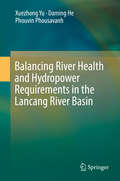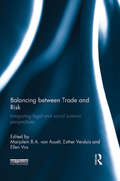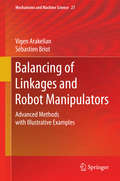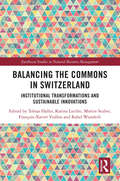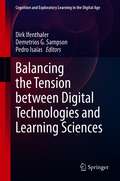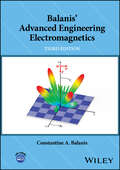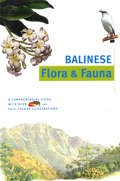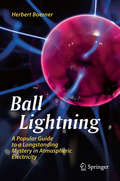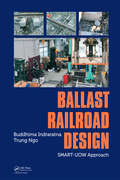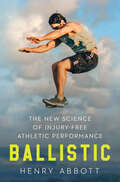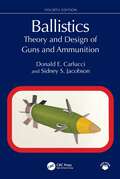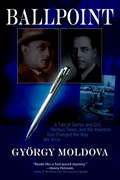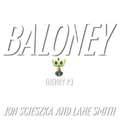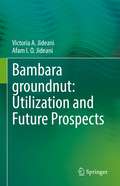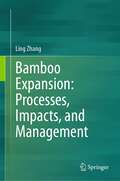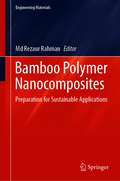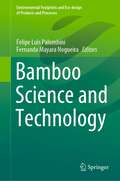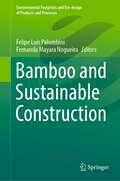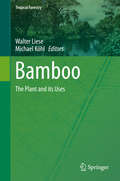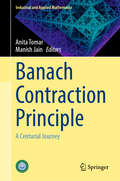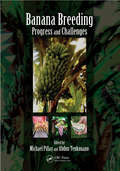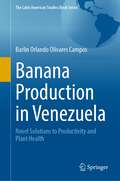- Table View
- List View
Balancing River Health and Hydropower Requirements in the Lancang River Basin
by Daming He Xuezhong Yu Phouvin PhousavanhThis book assesses river health in the Lancang River Basin with regard to the impacts of hydropower projects. It studies key components of the transboundary effects of Chinese dams on the Lancang River including its hydrology, sediment transport, water temperature, and fish community. It also investigates the specific impacts of hydropower on women’s lives and livelihoods, and factors that influence women’s participation in river health management. In closing, the lessons learned regarding environmental protection and hydropower development in the Lancang River Basin are shared, e.g. with hydropower developers and regulators in Laos.
Balancing between Trade and Risk: Integrating Legal and Social Science Perspectives
by Ellen Vos Marjolein B.A. van Asselt Esther VersluisThe trade aspects of risk and the risk aspects of trade deserve more systematic and genuine interdisciplinary attention if we are to really understand the global, international and supranational dimensions of risk regulation. This book brings together legal and social science research on risk regulation from across the world to explore risk regulation in a trade context. The interdisciplinary collaboration provided in this book is needed to address the trade versus risk balancing act both in empirical and theoretical terms. Although it is obvious that legal, social, cultural and political matters interfere with risk regulation, analyses in which these interferences are adequately considered are lacking. In one way or another, all chapters in this book address the issue of scientific uncertainty, the governance arrangements around expertise or both. Issues such as transparency, trust, legitimacy and precaution also become particularly important given the political, multi-actor and multi-level governance characteristics of the balancing act between trade and risk regulation. This book highlights and examines these concerns, going on to provide a critical assessment of the EU regulation of trade and risk both from external and internal perspectives. This book’s exploration of the balancing act between trade and risk regulation will be increasingly important to students of law and social sciences as they move to a shared, interdisciplinary understanding.
Balancing of Linkages and Robot Manipulators: Advanced Methods with Illustrative Examples (Mechanisms and Machine Science #27)
by Vigen Arakelian Sébastien BriotIn this book advanced balancing methods for planar and spatial linkages, hand operated and automatic robot manipulators are presented. It is organized into three main parts and eight chapters. The main parts are the introduction to balancing, the balancing of linkages and the balancing of robot manipulators. The review of state-of-the-art literature including more than 500 references discloses particularities of shaking force/moment balancing and gravity compensation methods. Then new methods for balancing of linkages are considered. Methods provided in the second part of the book deal with the partial and complete shaking force/moment balancing of various linkages. A new field for balancing methods applications is the design of mechanical systems for fast manipulation. Special attention is given to the shaking force/moment balancing of robot manipulators. Gravity balancing methods are also discussed. The suggested balancing methods are illustrated by numerous examples.
Balancing the Commons in Switzerland: Institutional Transformations and Sustainable Innovations (Earthscan Studies in Natural Resource Management)
by Tobias Haller, Karina Liechti, Martin Stuber, François-Xavier Viallon and Rahel WunderliBalancing the Commons in Switzerland outlines continuity and change in the management of common-pool resources such as pastures and forests in Switzerland. The book focusses on the differences and similarities between local institutions (rules and regulations) and forms of commoners’ organisations (civic communities and corporations) which have managed common property for several centuries and have shaped the cultural landscapes of Switzerland. At the core of the book are five case studies from the German, French and Italian speaking regions of Switzerland. Beginning in the late medieval ages and focussing on the transformative periods in the 19th and 20th Century, it traces the internal and external political, economic and societal changes and examines what impact these changes had on commoners. It goes beyond the work of Robert Netting and Elinor Ostrom, who discussed Swiss commons as a unique case of robustness, by analysing how local commoners reacted to, but also shaped changes by adapting and transforming common property institutions. Thus, the volume highlights how institutional changes in the management of the commons on the local level are embedded in the public policies of the respective cantons, and the state, which generates a high heterogeneity and an actual laboratory situation. It shows the very different ways that local collective organisations and their members have followed in order to cope with the loss of value of the commons and the increased workload for maintaining common property management. Providing insightful case studies of commons management, this volume delivers theoretical contributions and lessons to be learned for the commons worldwide. This book will be of great interest to students and scholars of the commons, natural resource management and agricultural development.
Balancing the Tension between Digital Technologies and Learning Sciences (Cognition and Exploratory Learning in the Digital Age)
by Dirk Ifenthaler Demetrios G. Sampson Pedro IsaíasThis volume focuses on the implications of digital technologies for educators and educational decision makers that is not widely represented in the literature. While there are many volumes on how one might integrate a particular technology, there are no volumes on how digital technologies can or should be exploited to address the needs and propel the benefits of large-scale teaching, learning and assessment.
Balanis' Advanced Engineering Electromagnetics
by Constantine A. BalanisBalanis’ Advanced Engineering Electromagnetics The latest edition of the foundational guide to advanced electromagnetics Balanis’ third edition of Advanced Engineering Electromagnetics - a global best-seller for over 30 years - covers the advanced knowledge engineers involved in electromagnetics need to know, particularly as the topic relates to the fast-moving, continuously evolving, and rapidly expanding field of wireless communications. The immense interest in wireless communications and the expected increase in wireless communications systems projects (antennas, microwaves and wireless communications) points to an increase in the number of engineers needed to specialize in this field. Highlights of the 3rd Edition include: A new chapter, on Artificial Impedance Surfaces (AIS), contains material on current and advanced EM technologies, including the exciting and fascinating topic of metasurfaces for: Control and broadband RCS reduction using checkerboard designs. Optimization of antenna fundamental parameters, such as: input impedance, directivity, realized gain, amplitude radiation pattern. Leaky-wave antennas using 1-D and 2-D polarization diverse-holographic high impedance metasurfaces for antenna radiation control and optimization. Associated MATLAB programs for the design of checkerboard metasurfaces for RCS reduction, and metasurface printed antennas and holographic L WA for radiation control and optimization. Throughout the book, there are: Additional examples, numerous end-of-chapter problems, and PPT notes. Fifty three MATLAB computer programs for computations, graphical visualizations and animations. Nearly 4,500 multicolor PowerPoint slides are available for self-study or lecture use.
Balinese Flora & Fauna Discover Indonesia
by Julian Davison Bruce GranquistThis book provides a general introduction to the natural history of Bali, looking at each of the major ecosystems in turn and highlighting their most salient and interesting features. Watercolor panoramas and illustrations of typical or otherwise significant plants and animals from each type of habitat complement the text and provide the reader with a visual reference for some of the sights he or she is most likely to see during a visit to the island.
Ball Lightning: A Popular Guide to a Longstanding Mystery in Atmospheric Electricity
by Herbert BoernerBall lightning is an enigma. These luminous objects that appear occasionally during thunderstorms and can reach several meters in diameter have been a mystery to science for about 200 years. Despite several thousands of reported observations, their nature is still unknown. In this book, well documented cases of ball lightning are described and used to unravel some aspects of this mysterious form of atmospheric electricity. Throughout the book, the author discusses the various facets of the problem in an accessible but rigorous style, delivering a readable and informative text that will captivate the curious reader. He finally reaches the surprising conclusion that the solution to this puzzle may have been hidden in plain sight for many years. A foreword by Earle Williams, leading lightning researcher at MIT, introduces the book.
Ballast Railroad Design: Smart-uow Approach
by Buddhima Indraratna Trung NgoThe rail network plays an essential role in transport infrastructure worldwide. A ballasted track is commonly used for several reasons, including economic considerations, load bearing capacity, rapid drainage and ease of maintenance. Given the ever-increasing demand for trains to carry heavier axle loads at greater speeds, traditional design and construction must undergo inevitable changes for sustainable performance. Ballast is an unbounded granular assembly that displaces when subjected to repeated train loading affecting track stability. During heavy haul operations, ballast progressively deteriorates and the infiltration of fluidized fines (mud pumping) from the underlying substructure and subgrade decreases its shear strength and also impedes drainage, while increasing track deformation and associated maintenance. Features: serves as a useful guide to assist the practitioner in new track design as well as remediating existing tracks. research discussed in this book has made considerable impact on the railway industry. resulting from collaborative research between academia and industry, incorporating sophisticated laboratory tests, computational modelling and field studies. This book presents a comprehensive procedure for the design of ballasted tracks based on a rational approach that combines extensive laboratory testing, computational modelling and field measurements conducted over the past two decades. Ballast Railroad Design: SMART-UOW Approach will not only become an imperative design aid for rail practitioners, but will also be a valuable resource for postgraduate students and researchers alike in railway engineering.
Ballistic: The New Science of Injury-Free Athletic Performance
by Henry AbbottA Next Big Idea Club Must-Read Injuries are not destiny. This revolutionary new account of the science of injury prevention shows how “ballistic” movement can help you get strong, stay healthy, and be elite. The biggest victories of medical science—over polio, smallpox, heart attacks, and the like—are stories of prevention. Then there’s sports, where we just run around until something breaks, leading to pain, frustration, and sometimes even expensive surgery. Injuries are a major cause of society’s growing mobility crisis. What if we could predict and prevent them? Blending cutting-edge science with gripping storytelling, award-winning data journalist and competitive amateur athlete Henry Abbott reveals that we are on the cusp of a new era in sports medicine, built around the science of ballistic movements—leaping and landing—and the unique fingerprint of your body’s physics. Abbott’s inspiring narrative tells the story of sports scientist Dr. Marcus Elliott and the Peak Performance Project (P3), who use technology to study how athletes move and why they get hurt. Applying machine learning and lessons from biomechanics, medicine, and physiology, doctors at P3 can now detect elevated risk of an ACL tear or a pulled hamstring like an echocardiogram can see warning signs of a heart attack. Their data-driven findings are full of surprises. Your body’s most important defense against knee and ankle injuries are the little-known muscles in the lower leg and hip area, which typical workouts rarely target. Similarly, the glutes—not the core—do the most to prevent back pain. Transformative benefits flow from training underappreciated kinds of athleticism like rotation, deceleration, and relaxation. Most of all, science shows that the best athletes don’t avoid ballistics—they master them. Through riveting stories of elite athletes overcoming injuries and pushing themselves to the limit, Abbott presents an evidence-based case for intervening early to protect our bodies. And he suggests that we can all harness the science of ballistic movement not just to run fast or jump high but to move with joy and lead fulfilling athletic lives.
Ballistics: Theory and Design of Guns and Ammunition
by Donald E. Carlucci Sidney S. JacobsonBallistics examines the analytical and computational tools for predicting a weapon’s behavior in terms of pressure, stress, and velocity, demonstrating their applications in ammunition and weapons design. It includes updated and revised equations, end-of-chapter problems, case studies, and practical examples.Explaining the physics of a gun launch, the book describes the behavior of the propelling charge that moves the projectile through the gun tube and the necessary methods to calculate how the projectile will fly. The new edition features a new chapter on closed vessel experimentation and analysis, which discusses closed bomb testing to incorporate new propellants into interior ballistics designs. It covers the mathematical fundamentals that are key to developing a safe and reliable gun system.With its thorough coverage of interior, exterior, and terminal ballistics, this new edition continues to be the standard resource for ballistics experts and researchers studying the technology of guns and ammunition and designing state-of-the-art propellants.Instructors will be able to utilize a Solutions Manual and Figure Slides for their course.
Ballistics: Theory and Design of Guns and Ammunition, Third Edition
by Donald E. Carlucci Sidney S. JacobsonWith new chapters, homework problems, case studies, figures, and examples, Ballistics: Theory and Design of Guns and Ammunition, Third Edition encourages superior design and innovative applications in the field of ballistics. It examines the analytical and computational tools for predicting a weapon’s behavior in terms of pressure, stress, and velocity, demonstrating their applications in ammunition and weapons design. New coverage in the Third Edition includes gas-powered guns, and naval ordinance. With its thorough coverage of interior, exterior and terminal ballistics, this new edition continues to be the standard resource for those studying the technology of guns and ammunition.
Balloon pulmonary angioplasty in patients with CTEPH
by Francesco Saia Nazzareno Galiè Hiromi MatsubaraThe only curative treatment currently available for chronic thromboembolic pulmonary hypertension (CTEPH) is surgical pulmonary endoarterectomy (PEA). However, several patients may have high risk factors for surgery, or a peripheral disease not amenable to surgical treatment; or else a residual pulmonary hypertension after PEA. Balloon pulmonary angioplasty (BPA) was recently developed to offer an alternative treatment for these patients. Extensive data has since confirmed the efficacy and relative safety of this procedure. However, there are several technical issues that have yet to be resolved. In addition, many cardiologists and pneumologists still know very little about the procedure itself and its potential.Exploring the clinical indications and technical aspects of BPA, this book offers a valuable reference guide for all those who would like to introduce or improve a BPA program, and for all those whose work involves treating this complex patient population.
Ballpoint
by Gyoergy Moldova David Robert EvansThe triumphs and the trials of the men who invented the modern ballpoint pen as they battled corporate greed, dark eras--and each other.László Bíró's last name is, in much of the world, a synonym for his revolutionary writing tool. But few people know that Bíró began his career in interwar Budapest as a journalist frustrated with spotty ink; that he escaped fascism by fleeing to Paris and, finally, to Buenos Aires; that a fellow Hungarian, Andor Goy, also played a vital role in the pen's development--and that, in a tragic twist of shared fate, business pressures and politics ultimately deprived both men of their rights to the ballpoint pen. Taking us from Hitler's Europe in 1938, to Argentina, where Bíró settled, and to Communist-era Hungary, where Goy lived out his life, Ballpoint is a painstakingly researched, absorbing narrative that reads simultaneously like a work of history and a novel.
Baloney (Henry P.)
by Jon ScieszkaThe twisted team that gave the world Squids Will Be Squids and The Stinky Cheese Man now delivers a whole lot of Baloney. <P><P> Henry is an alien schoolkid who needs to come up with one very good excuse to explain why he is late for szkola, again. Otherwise, his teacher Miss Bugscuffle promises, it's Permanent Lifelong Detention. Henry's tall tale of his lost zimulis-received from deep space by Jon Scieszka-is told in at least twenty different Earth languages and graphically recreated in Lane Smith's out-of-this-world illustrations. The unbelievable trip into Henry's wild universe may be the most original excuse ever for being late for szkola. Or it might just be Baloney.
Baltic Crustaceans
by Anna SzaniawskaThis book presents all Malacostracan cructaceans occurring in the Baltic Sea in water salinity from 2 to 15 psu. The Baltic sea is very special due to its low salinity and characteristic fauna. For each of the 58 species the systematic position, the origin and distribution in European waters are given, and the environmental preferences, the role in the food web and human economy described. The book describes the history of the Baltic sea and the occurrence of crustaceans in its history against the terms of hydrological conditions, explaining why in the Baltic sea only part of all marine crustaceans occur. The book is richly illustrated with photographs and beautiful pictures of animals specifically prepared for this book.
Bambara groundnut: Utilization and Future Prospects
by Victoria A. Jideani Afam I. JideaniThe Bambara groundnut (BGN) or Vigna subterranea is an extremely hardy grain legume. As it produces reasonable yields even under conditions of drought and low soil fertility, it is also a climate-smart crop. Previously underutilized, BGN is the subject of growing interest among researchers and consumers for its balanced nutritional profile. Indigenous consumers of BGN report medicinal benefits from the plant; however, such knowledge is at risk of being lost with the urbanization and changing lifestyles of younger generations. To date, there is no comprehensive resource on the Bambara groundnut, despite market demand for plant proteins around the globe. Authored by scientists who have researched and developed patents using BGN, Bambara Groundnut: Utilization and Future Prospects aims to fill this gap. The text provides in-depth coverage on breeding, food and feed utilization, medicinal benefits and future research prospects. Drawing on both indigenous knowledge and cutting-edge research, Bambara Groundnut is the first book to fully explore the potential of this remarkable crop.
Bamboo Expansion: Processes, Impacts, and Management
by Ling ZhangThis book highlights processes, impacts and management practices of bamboo expansion occurring in areas where it is distributed around the world. Although not conceptually plant invasions, bamboo expansion has been considered an “invasion” based on its characteristics and the impacts it caused on adjacent ecosystems it expanded into, including altered element cycling, transformed soil microbial community compositions, decreased biodiversity, fluctuated primary productions, etc. However, the processes and impacts during or after complete expansion and the underlying mechanisms of successful expansion, are still unclear. The ecological effects of bamboo expansion are not given full consideration and are not thoroughly understood. Based on the latest studies, this book synthesizes research progress of bamboo expansion effects on the soil abiotic environment, soil microbial community compositions, plant characteristics, ecosystem biodiversity, element cycling process, and ecological effects of primary management practice, etc. This book will provide a thorough understanding of ecological changes following bamboo expansions, benefit the effective control of expanding bamboo with respect to decreased biodiversity and mitigation of global change, and accurate prediction and evaluation of bamboo expansion impacts currently and in the future occur around the world. This book presents critical points that need further investigation based on the latest findings, which will be helpful for ecological researchers, policymakers, forestry workers, or graduate and PhD students.
Bamboo Polymer Nanocomposites: Preparation for Sustainable Applications (Engineering Materials)
by Md Rezaur RahmanThis bookshows how to enhance somebamboopropertiesandthesurface treatmentsforobtaininghigh strength nanocomposites. It describes the tensile, flexural and impact strength, surface behaviour, morphological analysis, infrared spectral functional analysis and thermal properties analysis of manufacture nanocomposites. It also investigates the optimization of fabrication techniquesto prepare bamboo nanocomposites reinforcedwithvarious polymers. The book alsodescribesenvironmental impact analysis of bamboo nanocomposites. This book concludes with the nano-enhancement on bamboo species to produce nanocomposites and possibleusage of nanocomposites materials in terms of sustainability and economics.
Bamboo Science and Technology (Environmental Footprints and Eco-design of Products and Processes)
by Felipe Luis Palombini Fernanda Mayara NogueiraBamboo is one of the most sustainable materials in nature due to its fast growth, rapid regeneration, outstanding mechanical properties, and applications in numerous industries. Latest technological advances have been allowing the plant to be studied and applied to exciting new projects. Being bamboo an icon of sustainable development, this book approaches the latest developments in the study of the plant, either as a natural resource or as a source of inspiration for more efficient designs. With the global urging demand for more sustainable practices, innovations in bamboo science and technology are key to the development of environmentally sound solutions.
Bamboo and Sustainable Construction (Environmental Footprints and Eco-design of Products and Processes)
by Felipe Luis Palombini Fernanda Mayara NogueiraBamboo is considered one of the most sustainable and versatile building materials, driving the development of multiple techniques for its study and utilization. With new techniques to better analyze, comprehend, and exploit its uses, the plant can be used in numerous applications. From direct building material to composites, this book explores the latest developments in the application of bamboo in the sustainable construction industry.
Bamboo: The Plant and its Uses (Tropical Forestry #10)
by Michael Köhl Walter LieseThis book presents the state-of-the-art knowledge on bamboo. It starts with an introduction to the plant's biology, its taxonomy, habitat, morphology and growth. The cultivation of bamboo is discussed in terms of silviculture, pests and diseases, and harvesting techniques. The book is completed by a comprehensive presentation of the properties of bamboo, its utilization and its preservation. Bamboo is the fastest-growing and most versatile plant on Earth. For centuries it has played an indispensible part in the daily life of millions of people in tropical countries. In recent decades it has gained increasing importance as a substitute for timber. The book was developed as a reference text for scientists, professionals, and graduate students with a strong interest in this unique plant.
Banach Contraction Principle: A Centurial Journey (Industrial and Applied Mathematics)
by Manish Jain Anita TomarThis book offers a comprehensive exploration of the Banach contraction principle and its many facets. A compilation of chapters authored by global experts, it is aimed at researchers and graduate students in mathematics. The content covers the Banach contraction principle, its generalizations, extensions, consequences and applications, focusing on both single-valued and multi-valued mappings across various spaces. While discussing theoretical foundations, this book uniquely emphasizes the practical applications of the Banach contraction principle in real-world problem-solving scenarios. Each chapter addresses specific topics, including fractals, fractional differentials, integral equations, elastic beam problems and mathematical modeling and analysis of electrical circuits. These diverse subjects showcase the principle&’s versatility in solving complex issues that go beyond theoretical mathematics. By highlighting Banach&’s contraction principle as a lasting legacy, the book not only honours past mathematical achievements but also anticipates future innovations in industrial and applied mathematics. It underscores the enduring relevance of the principle, ensuring its continued prominence in mathematical discourse and its pivotal role in driving advancements across the field. This comprehensive exploration catalyzes inspiring future developments in mathematical research.
Banana Breeding: Progress and Challenges
by Michael Pillay Abdou TenkouanoWith the current world population growth of 1.2%, the earth can expect to house 9-10 billion people by 2050. Food production, too, must increase to accommodate these numbers. Easy growing, high calorie, nutritious foods, such as bananas are the top priority as a solution to this imminent problem. The first comprehensive compendium on bananas in rec
Banana Production in Venezuela: Novel Solutions to Productivity and Plant Health (The Latin American Studies Book Series)
by Barlin Orlando Olivares CamposThis book presents an important contribution to the knowledge of the banana soils of Venezuela. Banana, the edible fruit of Musaceae, is a staple food for more than 400 million people worldwide due to their nutritional and energy attributes. This makes Musaceae a crop of worldwide relevance, particularly in tropical regions, highlighting the impact of improved Musaceae cropping systems in the current efforts worldwide oriented towards a new agricultural revolution based on sustainable intensification. To achieve this, better practices for food production based on scientific and technical research capable to consider the complexity and variability within the agri-food sector are necessary. The research presented in this book is oriented towards providing answers to the causes of two aspects considered of high relevance for banana production, both affecting productivity and sustainability, always addressed for the Venezuelan conditions, one of the world’s largest producing countries: 1- The impact of phytosanitary risks related to Fusarium Wilt (FW) and the influence of the soil on the incidence of Banana Wilt (BW); and 2- An observed trend towards loss of productivity and decline of soil quality in some commercial farms of Aragua and Trujillo states in Venezuela. The book presents a pioneering study in the application of categorical regression (CATREG) in the characterization of banana soils and analyses soil morphological variables, such as texture, dry consistency, biological activity, reaction to HCl, and type of structure to characterize soil productivity for growing healthy bananas. It develops, for the first time in Venezuela, risk analysis and climatic suitability maps for lethal wilt disease in bananas caused by Fusarium oxysporum f. sp. cubense (Foc) Tropical Race 4 (TR4) (syn. Fusarium odoratissimum). Innovative machine learning techniques are used to predict BW so that future crop development can be done more efficiently and sustainably.
